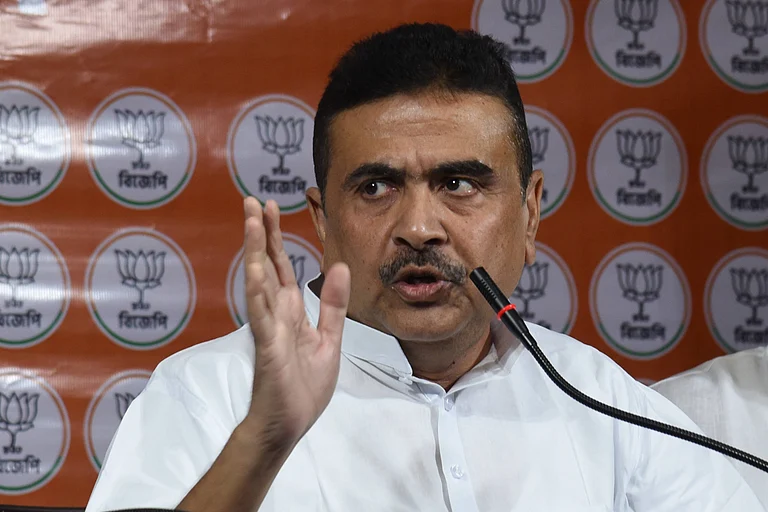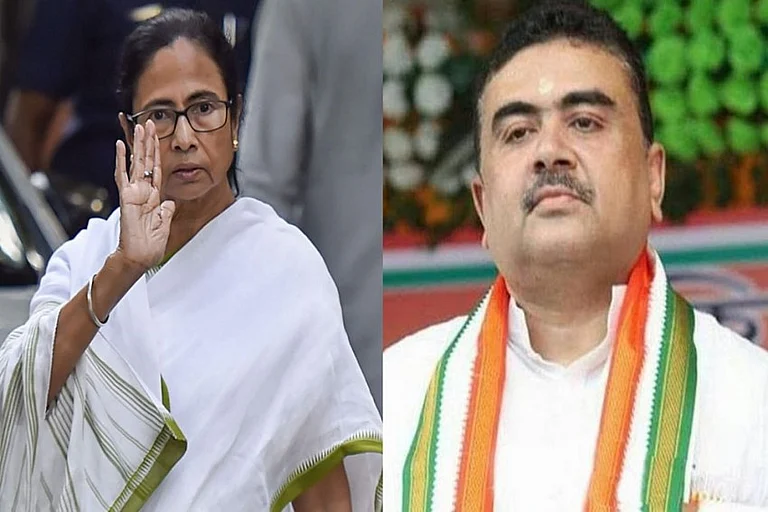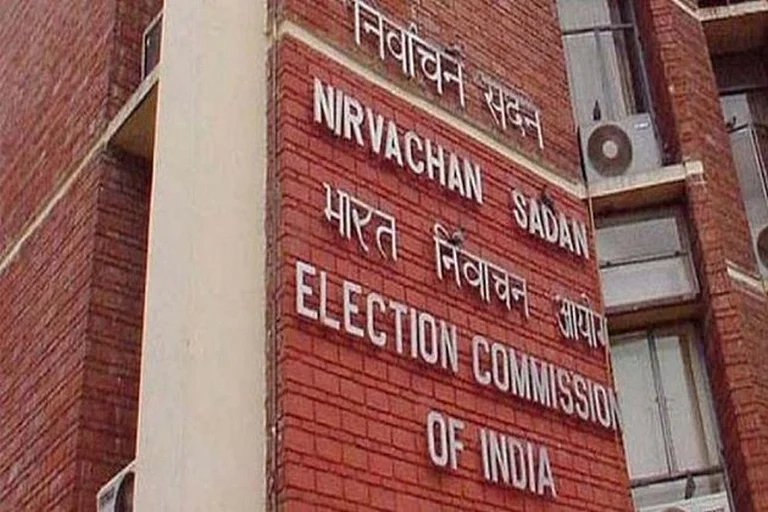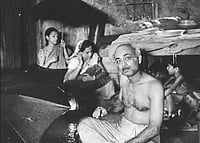How does a place grapple with a torment of memories? Nandigram still doesn’t have a clue. The town, which lies in Purba Medinipur district and falls under the Tamluk Lok Sabha constituency of West Bengal, walks into yet another election seeking answers that continue to evade the people of the town. In the heart of Nandigram, the streets are adorned with banners and flags of the three parties that are in the fray. With a heatwave warning sounded in the prelude to the elections across south Bengal, people walk the streets covering their faces. The place recuperates from the sights and sounds of a massacre that continues to haunt the locals and forces them to drift back to the days that had suddenly made an unassuming township the centrepiece of Bengal’s political shuffle.
March 14, 2007—a conversational marker in the town—is the date that witnessed 14 people being killed as Nandigram protested land acquisition for a proposed Special Economic Zone (SEZ) chemical plant. The then chief minister of the Left Front government, Buddhadeb Bhattacharjee, had struck a deal with Indonesian business giant Salim Group to mount a project that would require 10,000 acres of land across the proposed area of Nandigram, which drew the ire of the people and led to the killings. Seventeen years later, the hatred still lies firmly lodged in the words of the locals. It doesn’t come aimed at people or the parties anymore, but at how they are forced to stay in the dark, awaiting answers.
Torn Apart
Supriya, a woman in her 50s and a headmistress in a local government school, has seen the politics of the place take shape over the last three decades. “It has always been a calm and serene place. I’ve been witness to an event that altered the course of politics in Bengal. With time, old questions seem irrelevant, and give way to newer ones, but it’s not as black and white here,” she says.
Supriya drifts back to the days of 2007 and 2008 in a snap. “I remember the days so vividly. Walking past roadblocks and broken streets, making sure the bayonets of the marching people with guns don’t touch my daughter. It was a reflex to pull my daughter close to me whenever someone passed by. Murders became a staple,” she says. On being asked the usual question of accountability, she quickly says, “There were violent protests every day. It was difficult to separate the police from the people who were holding arms. I have seen people walking in protests, swiftly going behind huts and changing into police uniforms. In a game of optics, they needed bodies to fall to attract national attention.”

Nandigram is still torn, struggling to make sense of who sponsored the massacre that took numerous lives, including 14 on that very day at the Bhanga Bera Bridge in Nandigram. The members of the Bhumi Uchhed Pratirodh Committee—an organisation spearheaded by the Trinamool Congress (TMC) and supported by groups comprising the Socialist Unity Centre of India (SUCI), the Bharatiya Janata Party (BJP), the Congress and Naxalite outfits—were attacked with tear gas and bullets as thousands marched in resistance. Nandigram altered Chief Minister Mamata Banerjee’s political trajectory as she would go on to end the 34-year rule of the Left Front in Bengal.
While local people continue to harbour immense distrust and anger towards the CPI (M), who they believe triggered the reign of terror in the town, 17 years later, fingers cannot be strictly pointed at a single party. “How can the police wear slippers?” asks Supriya. “There were reports that crores of rupees were exchanged between the police and the protesters in Nandigram. We had heard people being informed that they would be killed in the evening, and their burnt bodies would be found in the haystacks. When the chief minister of a state had categorically instructed that no bullets should be fired, how were people killed? Something happened here that the people are still not privy to.”
When Promises Fade Away
In Sonachura village of Nandigram, about eight km from the heart of the town, the family of Subrata Samanta, one of the 14 killed on March 14, spends their days in despair. The wind rustles the leaves as work is underway for the promised permanent housing in front of a couple of huts by the pond. The two huts are shared by Subrata’s elder brother, Pabitra, his wife, their mother, and Pabitra’s two sons. “It’s been 17 years. He was just sleeping. I couldn’t return that day because the roads were blocked, and when I did, I returned to see the lifeless body of my brother,” says Pabitra, as his eyes welled up with tears.

Subrata’s mother, Saraswati Samanta, in her 70s now, smiles as she stares into the oblivion. “He wasn’t into anything. No politics, no fights. He was a beautiful 17-year-old boy and did all things that a boy of 17 would do—laugh, play, help with domestic work,” says Saraswati. Besides the monetary compensation offered by different leaders and the government, Subrata’s wife, who has deserted the family, has been working as a cook in a governmental department. “We got only Rs 30,000 of the Rs 10 lakh promised. We didn’t have money to sustain this family and our parents’ medical requirements. When our father passed away, we couldn’t even afford to give him proper medical attention. We were left with nothing and had to sell off parts of our land to sustain the family,” says Pabitra.
Seventeen years since the fateful day, the family has been seeking a job, but promises fade away as soon as the election season is over. “Both my sons have completed their higher secondary education, and a single job can save our family. Even that of a sweeper,” says Pabitra’s wife, as she rushes in to show their only framed picture of Subrata. “Look into his eyes. What wrong had he done? We didn’t even have a full picture of his. The part below his face—his body and clothes—were designed on a computer. No answers have been given. No help has been extended. Media attention comes only during elections,” she adds.

Sukumar Jana, the husband of the deceased Supriya Jana, smiles to himself when asked about March 14. “Everybody was carrying arms. Everybody was out on the streets. My son and I were searching for Supriya amidst the effect of the tear gas. As we decided to head home, a trolley carrying the body of my wife crossed us. We didn’t know how to react,” remembers a teary-eyed Sukumar. He is currently serving as the president of the Shahid Paribar, an organisation of 42 families who lost family members during the course of the movement. Sukumar says 13 families are yet to receive permanent jobs and houses, which were promised to them by Banerjee. “My son got a job in the Indian Railways, but the fight doesn’t end there. My struggle will continue till our entire family gets justice.”
Maa, Mati, Manush
Nandigram, a usually silent town, nurses strong political currents and opinions in the grassroots. While a section of the people is immune to the political games the town has seen over the years, a major section of the population feels Nandigram still carries some responsibility as the state prepares for the dance of democracy. Banerjee, or netri, as she is called by a major portion of people in Nandigram, continues to be a beacon of hope for them. “Nandigram sealed Banerjee’s game in 2007. And whatever happens, Nandigram will always stand with her,” says a villager. Both Pabitra and Sukumar feel Banerjee’s government has been instrumental in pulling Nandigram out of a terrifying past. “Didi has all the answers. And she will do everything for us, just like we will, but the problem lies somewhere else,” they say.
Nandigram is still torn, struggling to make sense of who sponsored the massacre that took numerous lives.
The local people believe that corruption has taken firm root in Bengal’s political parties. “The local leaders will steal a new slipper if they hear a family has bought new slippers. Families that are in dire need of a job must beg for decades, while families of these local leaders get as many as 5-6 jobs. From Cyclone Amphan relief funds to local resources, they have stolen everything,” says Pabitra. Sukumar echoes similar sentiments, “It is only because of our netri that we have hope. The local leaders are inefficient and corrupt. We have not been able to talk to her over the last few years, but if she comes here in the next few days, we will surely talk to her, and she will do the needful.”

While Nandigram gave birth to Banerjee’s iconic words of Maa, Mati, Manush (Mother, Land, and its People), the place is also considered to be a bastion of the Adhikari family. Suvendu Adhikari, turncoat BJP leader and the party’s face in Bengal and his father, Sisir Adhikari, are considered to be the guardians of this soil. The family led the Nandigram movement back in 2007. “Even when didi wasn’t here, Sisir and Suvendu babu were there to show us the way,” says Sukumar.
But the political winds have changed since the Adhikari family shifted allegiance. “Once saviours, they are today traitors for a large section of Nandigram’s people. “Nandigram has never had a place for the BJP. With over 40 per cent Muslim voters, Nandigram will never vote for a party which feeds on alienating Muslims,” says Srimanta Kumar, a villager. The constituency will witness a triangular contest—the BJP’s Abhijit Gangopadhyay, TMC’s Debangshu Bhattacharya and the CPI (M)’s Sayan Banerjee.
Speaking to Outlook, Sisir Adhikari, says: “People will say a lot of things, but I have seen everything. I used my personal money for the protests to support the people of my soil. And I can say with conviction that Banerjee contributed nothing to our movement. She turned her back on us when we needed her the most. And we are being called traitors? We fought hand-in-hand with the people of Nandigram while she fled at the sight of Communist flags.”
Nandigram had become a hot topic again during the 2021 assembly elections, when Banerjee was upstaged by her one-time protege Suvendu Adhikari by 1,000 votes, a result which remains controversial till date. “There wasn’t any controversy. The people have spoken, and the people will speak again. The maa is dead, the mati has been sold off and the manush have answered. The Tamluk constituency will give no chance to the TMC. And without the police and her machinery, the entire state will reject her,” adds Sisir Adhikari.
MORE FROM THIS ISSUE
Nandigram keeps embracing an existential doubt, as loyalties continue to shift. In the search of a guardian, the place awaits justice and answers, to fight a spectre.
(This first appeared in the print as 'Memory Metamorphosis')


































